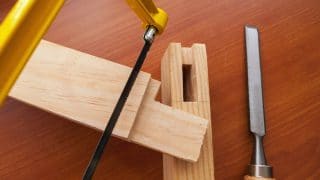
Regardless of whether you’re a professional builder or a weekend warrior, there are multi-use items that you’ll come to appreciate during years spent working with your hands. Tools like tape measures, hammers, and circular saws might come to mind, but certain materials can fit the bill as well. One of those materials is the humble wood shim, and every tradesperson with at least a bit of time in the field knows how important they are.
Wood shims are extremely affordable and can serve a ton of purposes. Let’s dig into what these little wooden wedges are and what they’re most commonly used for.
What is a wood shim?
A wood shim is a wedge-shaped piece of wood used to prop, adjust, hold, or tweak the position of an object. The wedges taper from less than 1/32-inch at their tip to ¼-inch at their thickest. They typically come in packs of 12, 42, or 100 and are usually quite inexpensive.
Wood shims come in a few material types. Most often, they’re made from softwoods like pine or fir, as these shims are easy to cut and shave. Also, the softer wood is less likely to snap and split when the installer drives a nail or screw through them. Shims are also available in cedar, which are more useful for outdoor or wet applications as they’re less prone to rotting. Plastic shims are also available.
There are also a few different sizes of wood shims:
- ¼” x 1¼” x 7¾”: The most common size, and popular for hanging doors, windows, and other gaps.
- ¼” x 1 ¼” x 11¾”: Also common, these shims are helpful for filling gaps over longer spans, such as for trim work, cabinets, and flooring applications. The longer length supports more material, as the slope is not as pronounced.
- Larger shims in various sizes: There are also large shims meant for a variety of tasks, and they come in random widths and lengths. Generally speaking, these shims are off-cuts from cedar shingle production, meaning they’re durable and easy to work with.
There are many ways to use a wood shim, the most common is to stack them on top of each other in opposing directions. This creates a flat, parallel surface. To fill the gap, the user can push or pull the ends toward or away from each other, adjusting the overall thickness of the stack.
Common uses for wood shims
Being so versatile, there are many ways to use a wood shim. However, below are some of the most common ways builders, DIYers, and tradespeople can use wood shims in various projects.
Trim Work
When installing baseboards, crown moulding, or other pieces of tight-fitting trim, wood shims can be irreplaceable. While the goal is always to cut and fit trim components as accurately as possible, gaps in the drywall, dips in the floor, and a myriad of other possibilities can cause tiny gaps. One way to seal those gaps up is to use a wood shim behind the trim, creating a tighter fit.
For irregular gaps, such as those that might be tight at the top but not at the bottom, the tapered shape is ideal. The carpenter can cut the shim to length and position it so it twists only the bottom of the board, creating a tight seam.
Cabinetry
For cabinetry to look and work properly (especially in conjunction with countertops), the boxes need to be flat and level. Cabinet installers use shims to ensure this occurs.
First, cabinet installers will use shims placed between the rear of two cabinets before screwing them together, as this helps keep the front of the cabinets in a perfectly flat plane. Next, they’ll position the cabinets in place and use shims to adjust their height and pitch, creating a level surface over top for counters.
Installing doors and windows
Arguably, the most common use for wood shims is for installing windows and doors in rough framing. Builders install windows and doors in rough openings which are substantially larger than the actual window or door. To fill in the gap and get the windows or doors level and plumb, installers use wood shims to position them.
Regardless of whether you’re a professional builder or a weekend warrior, there are multi-use items that you’ll come to appreciate during years spent working with your hands. Tools like tape measures, hammers, and circular saws might come to mind, but certain materials can fit the bill as well. One of those materials is the humble wood shim, and every tradesperson with at least a bit of time in the field knows how important they are.
Wood shims are extremely affordable and can serve a ton of purposes. Let’s dig into what these little wooden wedges are and what they’re most commonly used for.
What is a wood shim?
A wood shim is a wedge-shaped piece of wood used to prop, adjust, hold, or tweak the position of an object. The wedges taper from less than 1/32-inch at their tip to ¼-inch at their thickest. They typically come in packs of 12, 42, or 100 and are usually quite inexpensive.
Wood shims come in a few material types. Most often, they’re made from softwoods like pine or fir, as these shims are easy to cut and shave. Also, the softer wood is less likely to snap and split when the installer drives a nail or screw through them. Shims are also available in cedar, which are more useful for outdoor or wet applications as they’re less prone to rotting. Plastic shims are also available.
There are also a few different sizes of wood shims:
- ¼” x 1¼” x 7¾”: The most common size, and popular for hanging doors, windows, and other gaps.
- ¼” x 1 ¼” x 11¾”: Also common, these shims are helpful for filling gaps over longer spans, such as for trim work, cabinets, and flooring applications. The longer length supports more material, as the slope is not as pronounced.
- Larger shims in various sizes: There are also large shims meant for a variety of tasks, and they come in random widths and lengths. Generally speaking, these shims are off-cuts from cedar shingle production, meaning they’re durable and easy to work with.
There are many ways to use a wood shim, the most common is to stack them on top of each other in opposing directions. This creates a flat, parallel surface. To fill the gap, the user can push or pull the ends toward or away from each other, adjusting the overall thickness of the stack.
Common uses for wood shims
Being so versatile, there are many ways to use a wood shim. However, below are some of the most common ways builders, DIYers, and tradespeople can use wood shims in various projects.
Trim Work
When installing baseboards, crown moulding, or other pieces of tight-fitting trim, wood shims can be irreplaceable. While the goal is always to cut and fit trim components as accurately as possible, gaps in the drywall, dips in the floor, and a myriad of other possibilities can cause tiny gaps. One way to seal those gaps up is to use a wood shim behind the trim, creating a tighter fit.
For irregular gaps, such as those that might be tight at the top but not at the bottom, the tapered shape is ideal. The carpenter can cut the shim to length and position it so it twists only the bottom of the board, creating a tight seam.
Cabinetry
For cabinetry to look and work properly (especially in conjunction with countertops), the boxes need to be flat and level. Cabinet installers use shims to ensure this occurs.
First, cabinet installers will use shims placed between the rear of two cabinets before screwing them together, as this helps keep the front of the cabinets in a perfectly flat plane. Next, they’ll position the cabinets in place and use shims to adjust their height and pitch, creating a level surface over top for counters.
Installing doors and windows
Arguably, the most common use for wood shims is for installing windows and doors in rough framing. Builders install windows and doors in rough openings which are substantially larger than the actual window or door. To fill in the gap and get the windows or doors level and plumb, installers use wood shims to position them.
In almost all cases, installers will use two shims to create a flat, even surface. For large gaps, they might even add extra shims to fill in the gaps. When the trim is installed, the shims disappear from view.
Flatten floors
Whether it’s installing a new floor or taking the bounce and squeak out of an existing floor, wood shims are up for the job. By placing shims between the joists and the subfloor, any gaps that exist will tighten up. This provides the flooring installer with a flat surface for laying the new floor, or it can take the bounce and squeak out of an old floor.
Bathtub installations
Ideally, the floor underneath a bathtub surround or shower pan is level and flat, but that’s rarely the case (especially in older homes during renovations). Shims make it possible for an installer to adjust the pan or tub’s pitch back to level, ensuring that water runs to the drain instead of pooling to one side or the other.
In this case, plastic shims are usually best, as the extreme weight of a bathtub full of water will flatten a wood shim over time.
Wood shims vs. plastic shims: Which is best?
There’s one final point to consider regarding shims: wood vs. plastic. Wood shims are cheaper and easier to cut, shave, and shape. However, over time they can absorb water and rot. Also, extreme pressure from stone countertops, bathtubs full of water, or even heavy objects on a floor can cause the fibers and cells to crush, adjusting the object’s pitch.
In many cases, plastic shims are the superior choice. They’re generally stronger and they’re impervious to water. However, plastic shims are more expensive and more difficult to shape, which is worth keeping in mind when faced with the decision between the two types of shims.
MT Copeland offers video-based online classes that give you a foundation in construction fundamentals with real-world applications, like installing windows and doors. Classes include professionally produced videos taught by practicing craftspeople, and supplementary downloads like quizzes, blueprints, and other materials to help you master the skills.






